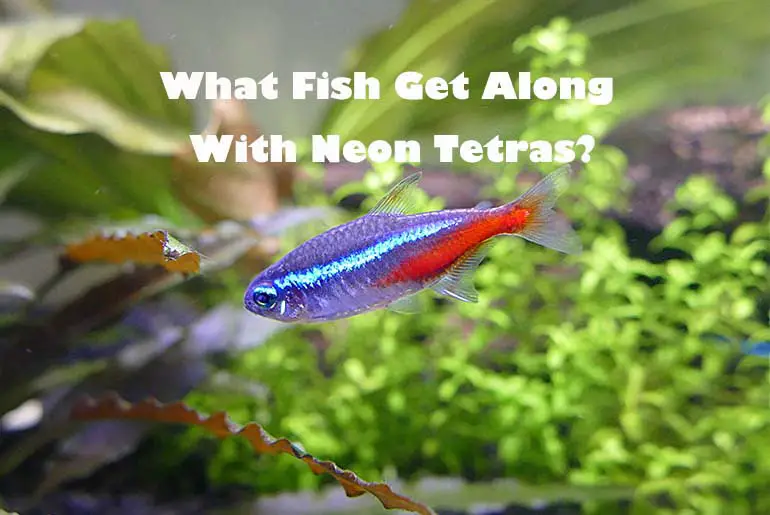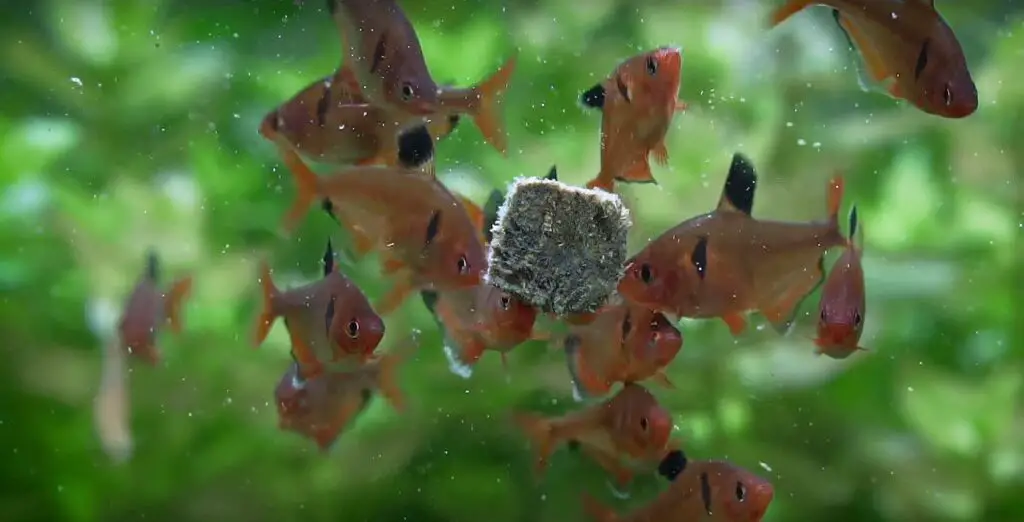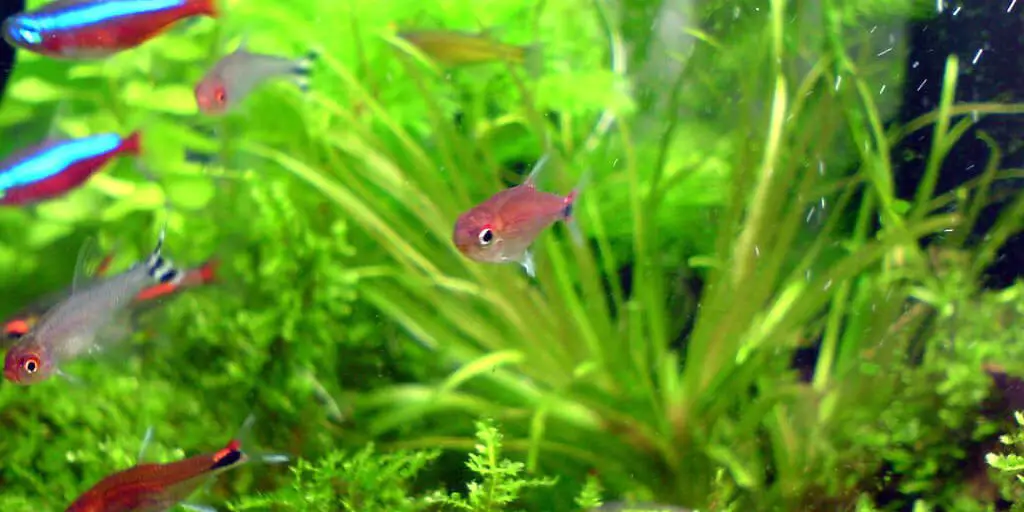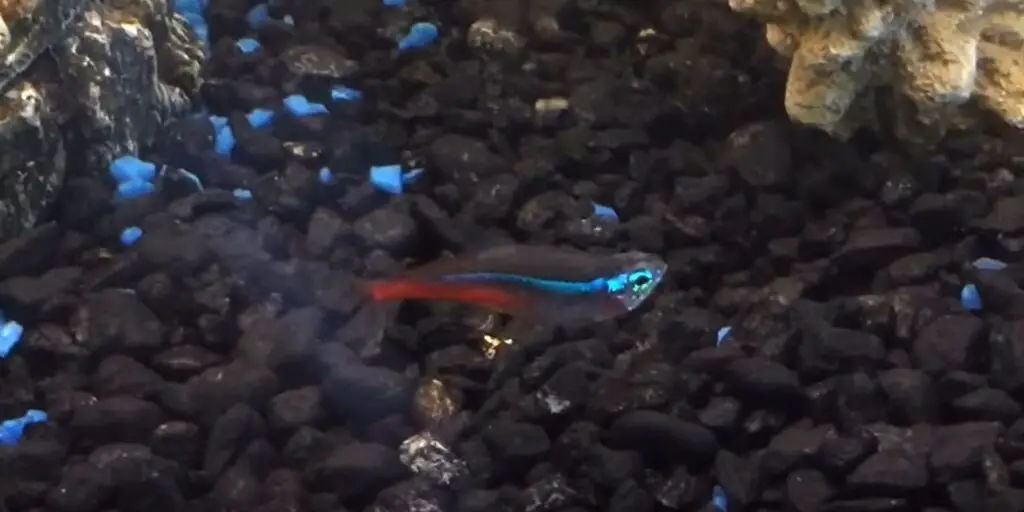It gets scary when you start to see your beautiful and colorful fish starting to lose color. The same thing can happen with neon tetras; it is necessary to know why. Why is your neon tetra turning white? What are the reasons for neon tetra color fading? Is there treatment available to stop neon tetra from fading color or getting its color back?
The reason for neon tetra color turning white and color fading is sometimes very simple but also scary. Low water temperature, Stress, bright lighting, improper cycling, etc. are some of the simple reasons for neon tetra color turning white and fading, while certain diseases like Neon Tetra Disease are responsible for color fading too, making itself the scary one.
Read this article to know the what, the why, the when, and the how related to neon tetras and color fading and the very reason why they are turning white all of a sudden.
Why Is Neon Tetra Turning White?
Well, it is normal to get scared when you see your beautiful colorful fish turning white for no apparent reason.
But it might be due to your carelessness and improper water parameters. When you see your neon tetra changing its color and going completely white, look at the temperature immediately.
The cold temperature is the main reason neon tetras lose color and go white. As you know, neon tetras are tropical fish that prefers warm water.
But when the cold season hits the environment, the water in the tank goes cold, too, if the heater isn’t working properly.
And neon tetras do not do well in the cold season either in absence of a heater. Also, you might have done some common mistakes while changing the water.
The water change in the aquarium plays a key role in deciding the very first temperature your neon tetras will face.
When you overdo the water change, you will be changing the temperature from warm to not-so-warm immediately.
This will lead to temperature fluctuation and cold weather for your neon tetras, hence the white color.
Neon Tetra Turning White Due To Low Water Temperature
So, there are various reasons for the color change in neon tetras from blue and red to white; I’ll help you with the most prominent reason here.
Let me tell you about the mistake I made when I was a beginner and apparently very careless.
It was winter season, and it was pretty cold outside. I had just done the aquarium water change the very day, and absent-mindedly or exclusively beginners mistake, I forgot to turn on the heater.
It was truly a nightmare when I came to think about it. That night when I looked at the aquarium, I saw my school of neon tetras sitting on the bottom of the tank, all white.
I immediately checked the temperature of the aquarium water, and it was just 15 degrees Celsius. All of them had lost their color and were sitting on the bottom of the tank, inactive as if they were in hibernation.
I immediately turned on the heater and turned off the aquarium lighting. I was hoping and praying for the return of their color and was pretty worried about my mistake.
But to my surprise and relief, the color of neon tetras was back, and they were actively swimming and playing the very next morning.
So, the cold season and low temperatures are a nightmare for neon tetras and a threat to their beautiful color.
Mechanism of Color Fading In Neon Tetras
Several crucial and important functions like sexual selection, camouflage, and protection from UV radiation determine the color fading and changing in neon tetras.
Role of Chromatophores
Chromatophores absorb the light rays and handle optical interference to give out the color in any fish. Chromatophores are the cells that produce pigment in the fish body, hence the coloring cells of neon tetras too.
When the combination of light transfer mechanisms in the chromatophores gives out color in neon tetras, Iridescence, fluorescence, refraction, and reflection are the light transfer mechanisms when chromatophores combine them.
Chromatophores are further divided into structural and pigmentary cells where the structural cells reflect the light rays and pigmentary cells absorb those rays.
Physiological or Morphological Changes
Now, the change in color in neon tetras is either physiological or morphological. The physiological change occurs when the membrane vesicles with pigmentary chromatophores show movements.
Small alterations in the distance between lamellae of structural chromatophores cause the change in these chromatophores.
Physiological Changes
This physiological change in the color of neon tetra depends on how long they are under exposure to light, be it seconds or hours.
This is why neon tetras start changing their color to violet-blue as soon as the tank goes dark. The cytoplasm layer expands and parts when the light is off, and no rays can enter these chromatophores.
When you expose them to light again, these neon tetras return to their normal color because the cytoplasm comes together again.
Morphological Changes
Let’s talk about the morphological change in the color of neon tetras. This basically occurs when your neon tetras contract some disease or are sick.
When the density of pigment amount in the cytoplasm of chromatophores starts to alter, morphological change occurs. This can take time and is quite slower than physiological change.
What Are The Reasons For Neon Tetra Color Fading?
It can be heartbreaking to see your fish losing all its color and even more stressful when you don’t know the reason.
Let’s learn about the reasons for neon tetra color fading. This will give you peace of mind to know sometimes it isn’t even a big thing for your neon tetra to lose color.
Neon tetras preserve their energy while resting and adapt to inconspicuous colors at night. It is normal, and it is okay with no reason to stress.
But yes, a BUT intervenes; there are other serious reasons for neon tetras color fading. Here they are:
Stress
Stress is like that evil stepmother of Cinderella for neon tetras, making them sick, weak, and scared to be shadowed.
It is never a good feeling when something bothers you, and you can’t do anything about it but hide in the corner.
When these neon tetras are stressed or depressed, they lose their beautiful color and become pale.
Here are a few reasons that might be stressing or depressing for your neon tetras. Please avoid this if you want to see neon tetras’ vibrant and beautiful color.
Change in Water Parameters
Neon tetras, like any other fish, are sensitive and delicate, although they are known to be hardy. The change in water parameters can, however, irritate your neon tetras.
The continuous fluctuation from the ideal water quality can make tetras stressed and depressed, thus causing discoloration.
You can get a deeper knowledge on what is the appropriate water parameter for your neon tetra to keep them colorful and happy.
Bright Lighting
Neon tetras maintain their circadian rhythm while you provide them with 12 to 14 hours of light. Any more than that is just stressful exposure.
You need to have an automatic timer set up to switch off the light after certain hours. Neon tetras are familiar and native to the low light region and want the same in captivity.
Prolonged exposure to a high watt of light can be stressful for these fish and even gradually make them lose their color. To be on the safe side, you can go for Tetra Hidden LED Stick Light for Aquariums, Brilliant White.
Solo Swimming
Neon tetras are schooling fish and can’t live alone. You are doing an evil thing if you keep them alone without their family.
You are just making them stressed, depressed, and discolored, and sometimes pushing them to their death bed. Please do yourself and your neon tetra a favor and get a whole school of them. They are not even expensive.
You can better understand how many neon tetras you can keep in one school from here.
Incompatible Tank Mates
If these tetras don’t have the tank mates they like or are compatible with, it is scary and stressful for these fish. These tetras search hiding spots and run away more often from their tank mates.
Neon tetras are peaceful fish with a non-aggressive temperament. So, if you keep them with aggressive and hyperactive fish, it is stressful for these neon tetras as they can’t keep up with their tank mates.
Bullying
Larger fish eats smaller fish. That is a well-known fact, and neon tetras are small fish. So, when they are kept with larger fish in a community tank, there is a high chance of larger fish bullying these ones.
Bullying can cause stress and depression even in human beings; these small neon tetras can barely keep up with it.
This stress and depression from bullying can cause them to lose color and become pale and discolored.
Improper Cycling of the Aquarium
Aquarium cycling plays the main role in eliminating toxicity like ammonia poisoning, nitrite, and excess nitrate.
This good thing can change into the worst nightmare for you and your neon tetras when done improperly.
Your fish will definitely get stressed with all the ammonia, pollutants, and other waste products in the tank. Hence, you’ll start seeing the change in their natural color and conversion into something unpleasant.
Disease
Color fading in the neon tetras is a major sign to show your fish is infected with some disease. Most diseases start to show with these very symptoms and help you know if treatment is needed.
When your neon tetra is infected with Neon Tetra Disease, they lose its vibrant color and look pale. Here are some of the diseases your neon tetra can suffer and how you can treat and avoid them.
This is one of the first symptoms they show when they are infected. Although there is no going back from this disease, you need to prevent the disease from spreading to other neon tetras in the tank.
Why Do Neon Tetras Lose Their Color While Resting?
Chromatophores, the cells that produce pigment in fish, require a certain level of energy to give color out.
So, when you see them resting or sleeping, they are saving energy or using it elsewhere.
That’s why the color fades or discolors during their resting period because of their energy-saving mode.
Color is secondary when neon tetra uses its energy to do something else or nothing. So, it is quite normal and okay to see them changing color while resting.
Do All Neon Tetras Lose Color At Night?
When you see your beloved colorful fish losing its color at night, it is natural to feel sad and worried. But do all of them lose color at night? That’s the main question you need to ask.
Well, the answer is no. Not all neon tetras lose their color at night. The color fading mechanism in neon tetras varies according to the sleeping time, levels of rest, and also on each fish.
Neon tetras are known to retain the vibrancy in darkness too. There is always a certain difference between each fish living in the same parameters. The neon tetras basically adapt to the inconspicuous color when the lighting is reduced or off.
The intensity by which these neon tetras lose their color depends on the fact of how the fish is individual. Personality and personal traits determine how and when they will lose their color.
Some neon tetras color will fade immediately after the light is off, whereas some will hold on to some vibrancy.
You have to monitor each neon tetras closely to know the mannerisms. It will be easier for you to understand what you are to expect from each of them.
Treatment For Color Fading Of Neon Tetra
Sometimes the mere reason your tetra is losing color is the common external factor we overlook. Once you have the upper hand on those factors, you’ll have your colorful neon tetra in no time.
Avoid Factors That Stresses Neon Tetras
Deranged water parameters, scary tank mates, crowded aquariums, small tanks, etc., are some prime factors that cause stress to your neon tetras.
These sensitive fish are delicate yet delightful. Who wouldn’t want them to be happy and retain their color all the time?
Aren’t they the cutest when they swim happily with no stress, along with their colorful school? You need to get an aquarium filter to maintain the tank’s water quality along with other parameters.
- When you maintain the ideal water parameters of the tetra tank, there is a high probability or chance you’ll have your colorful neon tetras back.
- Avoid larger fish or bully ones in the tank along with neon tetras; it is scary for these delicate fish, who will run for life.
- Give them enough space to swim around, and keep live plants in the tetra tank, so they have spacious space to swim around and enough places to hide.
- You must know how to adjust the pH and maintain the water hardness of the tetra tank.
Neon Tetras Are Not Good With Temperature Changes
Neon Tetras may be hardy, but they are still the same old tropical fish people bring into the aquarium life from the Amazon Basin of South America.
Being a tropical fish, temperature plays an important role in deciding whether neon tetras will live in captivity.
The slightest fluctuation and consistency in the fluctuation is a curse for your neon tetras. If you’re successful in maintaining the ideal temperature all the time, your neon tetras have less chance of losing color.
Get a heater. This is the simplest and highly recommended solution to many of your problems in the tetra tank.
Hitop Submersible Adjustable Aquarium Heater is highly recommended for your neon tetra tank.
Dim The Tank Light In The Neon Tetra Tank
Neon Tetras don’t need light all the time, and 12 to 14 hours of light will do them well. Don’t overdo anything. Extreme exposure to light can make your tetra lose its color.
Go for moderate aquarium light with low power of between 18 to 40 watts for 12 to 14 hours of lighting. This will be sufficient for your neon tetras.
NICREW ClassicLED Aquarium Light will also be another ideal for the aquarium, with moderate lighting for the neon tetra tank.
Action Towards Disease In Neon Tetra
Unfortunately, there is no particular treatment for Neon Tetra Disease. The major rule is to prevent further contamination.
There are some measures you can take to prevent the disease from occurring beforehand.
“Prevention is better than cure” make this your motto even with your neon tetras as you do with yourself.
Separate Infected Inhabitants
If you see any of the neon tetra sluggish, discolored, and passive, separate them immediately from the others.
The disease can be contagious so you must keep ill neon tetra in the quarantine tank so that you don’t end up with a tank full of sick discolored fish.
Avoid Purchasing Sick Fish
You need to be careful when you are about to purchase a new neon tetra. Ask your breeder every little detail about the parent neon tetra and the one you are about to buy.
Avoid buying any fish from a breeder with no background info or papers. Keep in touch with well-reputed breeders and purchase neon tetras only after a full health check.
Quarantine Your New Fish
You don’t know what circumstances your new neon tetras might have been through. It is necessary to keep them separate after you bring them from the breeder.
Keep a separate quarantine tank to keep new fish till they show no signs and symptoms of any disease. Yet again, ‘Prevention is better than cure.’
Maintain Good Water Quality
The main reason any disease attacks your neon tetra is improper water quality. Moreover, maintaining the water to its epitome is something quite simple but tricky to achieve.
Get a canister or hang on the filter for your tetra tank, and you’ll subside all your worries without even breaking a sweat.
It is a simple yet efficient solution with a basic application process. Alike a heater, a filter is the crucial equipment that you need to place in the tetra tank.
Get The Foods From Respected Sources
An unhealthy diet is a profanity you would most likely avoid when it comes to you, your body, your kids, or your family.
You need to do the same with your neon tetras. Give them food only from the reputed brand and sources. It is even better to go for the recommendation about the neon tetra diet.
What Can Be The Best Ways To Spot The Disease Earlier In Neon Tetra?
Spotting any disease in neon tetra fish is not rocket science. It is quite simple if you know what to look at.
Here are the symptoms you might foresee when your neon tetra starts getting sick, in this order exactly.
- These neon tetras seem restless.
- Neon tetra starts to discolor often in one part at a time.
- Lumpiness in the body due to the development of cysts in the muscles.
- Difficulty in swimming, and you can see the struggle clearly in your neon tetras.
- Curved spines when the disease becomes advanced.
- Fin rot and bloating are other signs when they start getting sick.
Frequently Asked Questions
Here are answers to some common and frequently asked questions about neon tetras, and you might need to have these on your mind as well.
Do Neon Tetras Glow In The Dark?
No, actually, they don’t. These neon tetras have the most beautiful color combination in their body, but glowing is definitely not one of their unique traits.
However, there is the slightest chance the iridescent blue color they have has reflective scales that will probably seem as if they are contrasting with bright red color towards the tail.
Why Are My Neon Tetras Staying At The Bottom Of The Tank?
One of the symptoms that neon tetras show when they are sick is staying at the bottom of the tank. They are not bottom dwellers and barely hang out on the bottom of the tank.
So, if you see them dwelling on the bottom and staying there for a long time, look at them closely for other signs and symptoms.
Your neon tetra may be infected and on the verge of contagious to other tank mates. Separate them quickly and treat them properly.
Wrap-Up
If you’re the proud owner of a neon tetra, you might have noticed that their vibrant colors aren’t quite as bright as they used to be. Don’t worry, it’s a common problem – but that doesn’t mean you should ignore it! Sometimes, color fading can be a sign of a more serious issue lurking in your fish tank.
So keep an eye out for any other strange behaviors or symptoms, and make sure your water parameters are spot-on. And don’t forget about the other factors that can affect your tetra’s colors, like stress or a poor diet. But don’t stress yourself out too much – if you’re taking good care of your neon tetra, they’ll likely bounce back in no time. Just sit back, relax, and enjoy the colorful fishy world you’ve created!
Good Luck!
Happy Fish Keeping!





